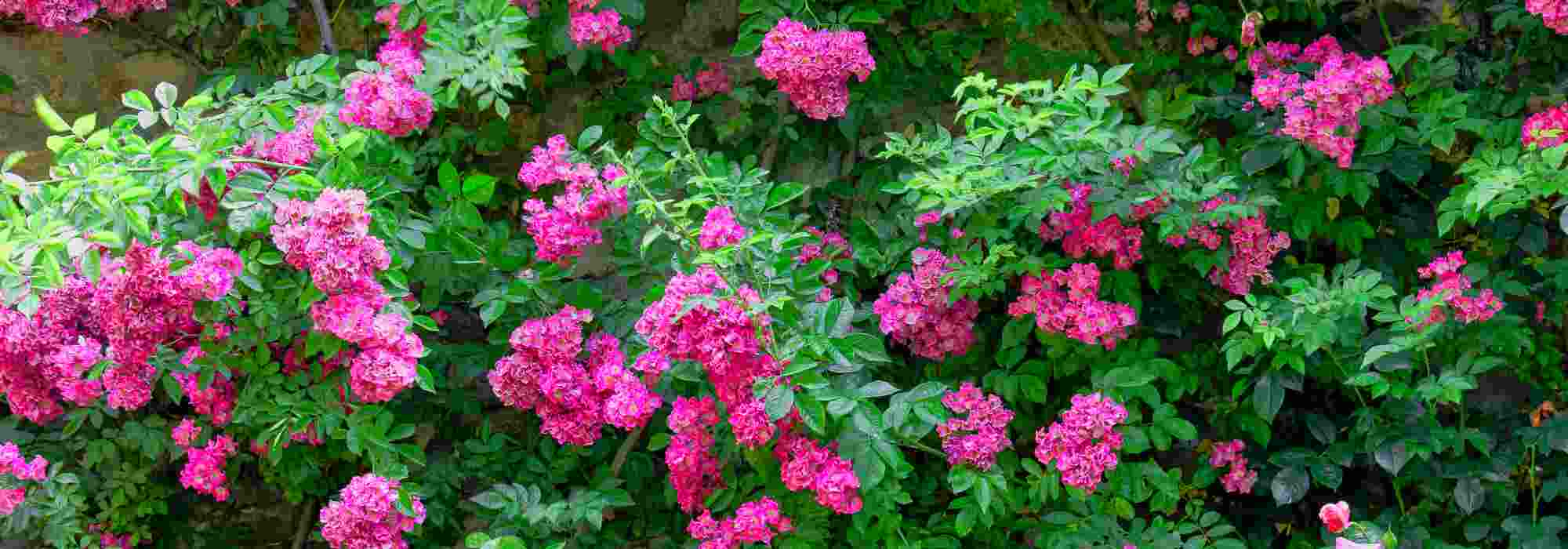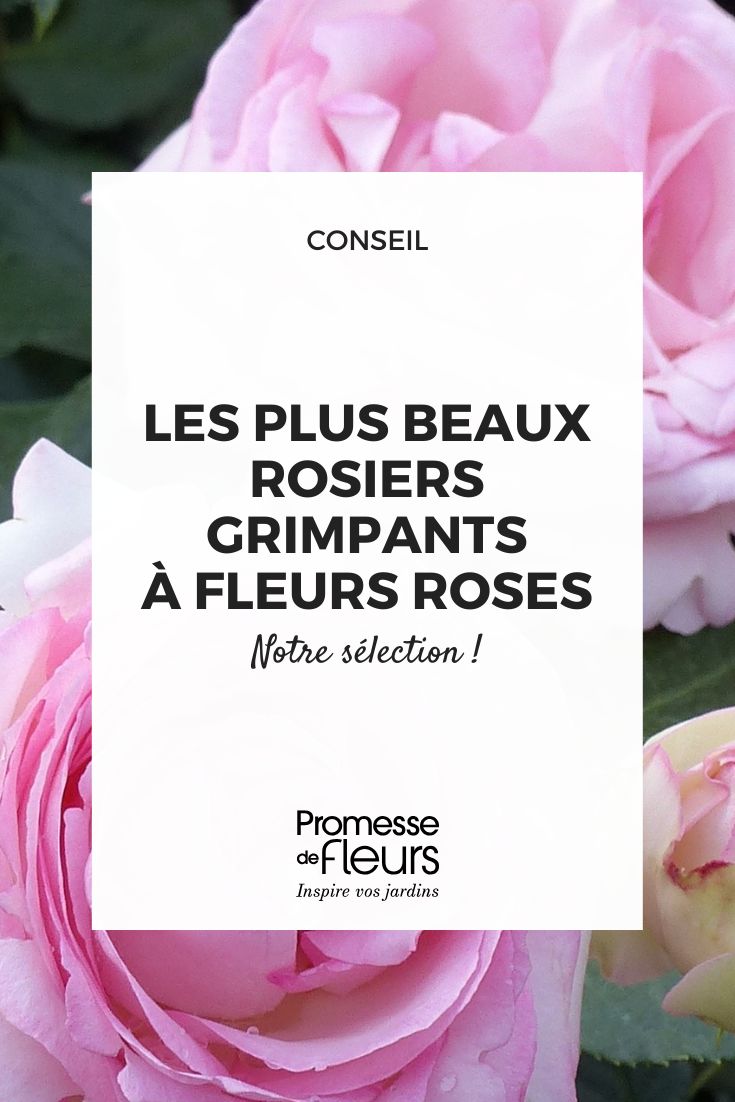
Our selection of pink-flowered climbing roses
The charming appeal of romantic gardens!
Contents
Roses, including climbing roses, are so numerous that it’s easy to get a bit lost if you’re not familiar with them. To make it easier for you to choose a climbing rose with pink flowers, an essential for any romantic garden, we’ll guide you through some of the most beautiful varieties. Fragrant, with large or small flowers, liana roses, perpetual or not, in soft or vibrant pink, all these magnificent roses are here to charm you!
Climbing roses with pink flowers: the timeless classics
These roses are among the classics, commonly found in many gardens, yet this takes nothing away from their appeal…
- ‘Pierre de Ronsard’: the quintessential choice, perhaps the most famous, with its large, densely petalled double flowers in a fresh pink shaded with carmine. Floriferous and perpetual, it climbs to a moderate height of 2.50 m. Ideal in full sun.
- ‘New Dawn’: an award-winning variety, dating back to 1930, and widely used in England. One of the most romantic, with pale pearly pink, slightly crumpled flowers. It blooms in early summer and repeats in autumn. Note that its flowers withstand summer rain quite well and it is highly disease-resistant.
- ‘Albertine’: another classic, though not perpetual and very thorny, with large double flowers wavering between salmon and candy pink. It climbs up to 4m in height.
- Ghislaine de Féligonde ‘Pink’ : its pompon flowers are alluring! It reaches 3 m in height and is moderately perpetual. This pink version of the famous yellow cultivar will shine in partial shade.
Pair them with large-flowered blue or purple clematis to enhance their romantic charm.

‘Pierre de Ronsard’ rose, ‘Albertine’ rose and ‘New Dawn’ rose
Read also
Climbing roses: the 10 best varietiesthe most fragrant pink-flowered climbing roses
Roses that perfume the garden, often in the evening. These varieties are particularly renowned for their exceptional fragrance:
- ‘Laguna’: A deep pink, it delights the senses with notes of citrus trees, patchouli, and lychee. Its large flowers (10 cm) are a rich pink. It is also valued for its disease resistance.
- ‘Zéphirine Drouhin’: Its scent exudes powerful red fruit fragrances. This small thornless climber (3 m) is a must-have for a scented garden! Its semi-double, cyclamen-pink flowers bloom abundantly in spring and lightly repeat in autumn.
- ‘Mme Isaac Pereire’: Impossible not to mention this rose, famed for its scent! A small, flexible climber, best trained on a support (up to 2.50 m). It reblooms well in September, producing large, very double carmine-pink flowers with a warm, headed fragrance.
- ‘Ernest Calvat’: A sport of ‘Mme Isaac Pereire’, it retains its parent’s powerful fragrance. Its lighter colour is charming, with old-fashioned, densely petalled blooms. It also stays compact, reaching about 2.25 m in height.
Plant them near pathways or seating areas, alongside lavenders or fragrant phlox.

‘Laguna’, ‘Zéphirine Drouhin’, and ‘Mme Isaac Pereire’ roses
Pink large-flowered climbing roses
Besides ‘New Dawn’ and ‘Albertine’ already mentioned among the classics, here are some other climbing roses whose enormous flowers, at least 10 cm in diameter, delight during the summer season:
- ‘Caroline Testout’ CLG: This hybrid tea dates back to 1901. It is perpetual, lightly fragrant, and bears heavy globular flowers in bright pink. Perfect for covering facades or large walls, as it climbs to 4m, sometimes up to 6m. It may be less perpetual depending on growing conditions.
- ‘Pierre de Ronsard’: Mentioned again here, it has been widely planted but remains magical with its soft pink blooms. A Meilland creation from 1985. Height: 1.50m to 2.50m.
- ‘Belle de Londres’ (Compassion): Very perpetual, highly fragrant, ultra-elegant, disease-resistant… in short, it has only virtues! Its turbinate roses are pale salmon-pink, slightly apricot-toned. Climbs up to around 3m.
- Rose Céleste®: A very perpetual rose, covered in blooms all season, climbing between 1.50m and 2.20m—perfect for dressing up a fence. Its large semi-double flowers are a soft ochre-pink and fragrant. Highly disease-resistant.
- ‘Laguna’®: A stunning deep pink, with 10cm double flowers exuding old rose charm! ‘Laguna’ climbs up to 2.50m and enchants with its highly fragrant flower clusters. Exceptionally floriferous and perpetual. A Kordes rose breeder creation.
Highlight their elegance with structural perennials like delphiniums or foxgloves.

Rose ‘Albertine’ (left) and rose ‘Belle de Londres’ in the centre (©Wikimedia Commons-Dinkum). On the right, the rose ‘Mme Caroline Testout’
Pink small-flowered climbing roses
In contrast to the roses mentioned above, these roses feature small flowers (between 3 and 7 cm) that are absolutely exquisite! Among them, you’ll find many with eglantine-like flowers. They possess the charm of English gardens and countryside gardens, working wonders on romantic pergolas and arches.
- ‘Maria Lisa’: an old variety from 1936, with an undeniable, enchanting appeal. The small (3 cm) bright pink flowers bloom continuously throughout spring. It has no thorns! Perfect for climbing up a tree, planting in a hedge, or even standing alone in a short grass meadow where it can grow up to 5 m tall.
- ‘Sourire d’Isabelle’: a delight with its myriad of flowers clustered in bouquets, lightly scented with exotic fruit. This perpetual rose is refreshing with its pastel pink colour, fading as the flowers fade, and grows between 2.50 m and 3 m. A 2019 introduction by Lens Roses.
- ‘Libertas’: this medium-sized climbing rose charms us with its clusters of small (3 cm) deep pink-red flowers, a white centre, and golden stamens. It grows to about 2.50-3.50 m in height. It received the ADR certificate in 2013. We love the brilliance of its perpetual flowering, perfect for climbing trellises and arches.
Enhance the floral abundance with lightly flowering clematis or perennial sweet peas.

Rose ‘Maria Lisa’, rose ‘Sourire d’Isabelle’, and rose ‘Libertas’
Pink-powdered climbing roses
While many roses fade over the weeks, some roses are born with a diaphanous or pale pink hue. We adore their delicate, almost powdered tones, which pair beautifully with other pastel shades or contrast wonderfully with roses and perennials in richer colours.
- ‘Albertine’, a fragrant salmon-pink rose, non-perpetual, growing 2 to 6 m, with clustered flowers.
- ‘Pierre de Ronsard’, which meets many criteria, particularly for its plump, fresh pink flowers that fade as they open.
- ‘New Dawn’, yet again, charms with its soft pink hue, is perpetual and grows 3 to 6 m tall.
- ‘Domaine de Chantilly’ displays a delicate gradient from soft pink to cream with an orange centre.
- Nahéma®: this rose could also feature in the fragrant roses category, evoking the famous Guerlain perfume. This rose from the Delbard collection boasts plump, sugared-almond pink flowers. Perpetual (flowering from May to October), floriferous, and fragrant, it’s a must-have among pink climbers for the garden. It climbs up to 3 m.
- ‘Mme Alfred Carrière’: this famous old climbing rose with large white flowers and a pink centre produces double flowers and was created in 1879. Between a climbing rose and a liana, it flowers from June to September, can reach over 4 metres in height and 3 metres in width. Highly fragrant and very perpetual, it’s a must for pale, almost translucent roses. Its flexible branches bear almost no thorns.
- ‘Siluetta Romantic’: a climbing rose with double flowers in a very soft pastel pink, part of a recent range of mini climbers developed by Kordes, noted for its dense flowers and moderate growth.
- ‘Santa Catalina’, a perpetual rose of great delicacy, pink with apricot tones, dating back to 1970. It grows 2 to 4 m tall.
Pair them with campanulas, nepeta, or gypsophila for a dreamy, pastel effect.

Rose ‘Nahéma®, rose ‘Clair Matin’ (©Flickr-Small curio) and rose ‘Mme Alfred Carrière’
Salmon-pink to deep pink climbing roses
To contrast with roses in powdery hues, here are roses with bolder colours or in apricot and salmon tones – perfect for introducing these soft shades alongside other roses or purple climbing varieties: the effect is irresistible!
- ‘Crimson Shower’ produces an abundance of carmine-red, lightly scented flowers. Also perpetual, it can reach up to 2.5 metres in height.
- Rose ‘Laguna’: This climbing rose stands out with its large, double flowers in a rich pink, exuding an intoxicating fragrance with notes of citrus trees, patchouli and lychee. It is perpetual, disease-resistant and climbs up to 2.50 metres tall.
- ‘Clair Matin’ is distinguished by its semi-double, soft pink, lightly scented flowers. It is perpetual and can grow up to 3 metres tall, ideal for covering a pergola or wall.
- ‘William Morris’: Fragrant, double apricot-pink flowers on a very healthy rose bush. This is a David Austin introduction from 1998.
- Rose ‘Colette Meiroupis’: Another salmon-coloured rose with double flowers, compact in size, reaching around 2.50 metres in height with a narrower spread. This is a Meilland creation, highly perpetual.
Create a striking contrast with shrubby salvias, verbascums or daylilies.

Rose ‘Crimson Shower’, rose ‘Laguna’ and rose ‘William Morris’
The tallest pink climbing roses: liana roses
They are invaders, and that’s precisely why we choose them! Climbing up to 6-10 metres high, these are perfect roses for scaling tall trees. They often bear small or medium-sized flowers of great delicacy and are not perpetual. All these rose varieties possess the charm of English roses, the old-fashioned roses of yesteryear. They were adored at the turn of the century and remain prized and relevant for their ornamental qualities.
- ‘Kew Rambler’: This rose with small single flowers in salmon-pink produces an abundance of blooms quite late in July. When well-trained, it grows up to 7 m tall with a spread of 3 m. It takes its name from Kew Gardens near London, where it originated in 1913.
- Rosa banksiae ‘Rosea’: The pink version of the famous yellow Banks’ rose. It also thrives in mild climates, flowers early in the season (April), and is thornless. It displays small, soft pink flowers, very bright and clustered in bouquets. It tolerates dry soils well.
- ‘Maria Lisa’: Absolutely enchanting, it is laden with flowers in May and June. Though not perpetual, we adore its bright pink blooms with white centres, revealing golden stamens. Disease-resistant, this historic variety from 1936 grows very rapidly and is a must-have in the garden. This grand romantic climber reaches 4 m, even 5 m in height.
- ‘Paul’s Himalayan Musk’: A wonder among wonders, a classic for extraordinary expansion, reaching up to 8 m in height. A ravishing porcelain-pink and an avalanche of small double flowers in clusters. It tolerates chalky soils and partial shade. Perfect for climbing a tree.
Train them up large deciduous trees or pair them with honeysuckles for a wild and abundant effect.
Also, check out our article 8 pink-flowered rambling roses!

‘Kew Rambler’ rose, Rosa banksiae ‘Rosea’, and ‘Paul’s Himalayan Musk’ rose
- Subscribe!
- Contents
































Comments